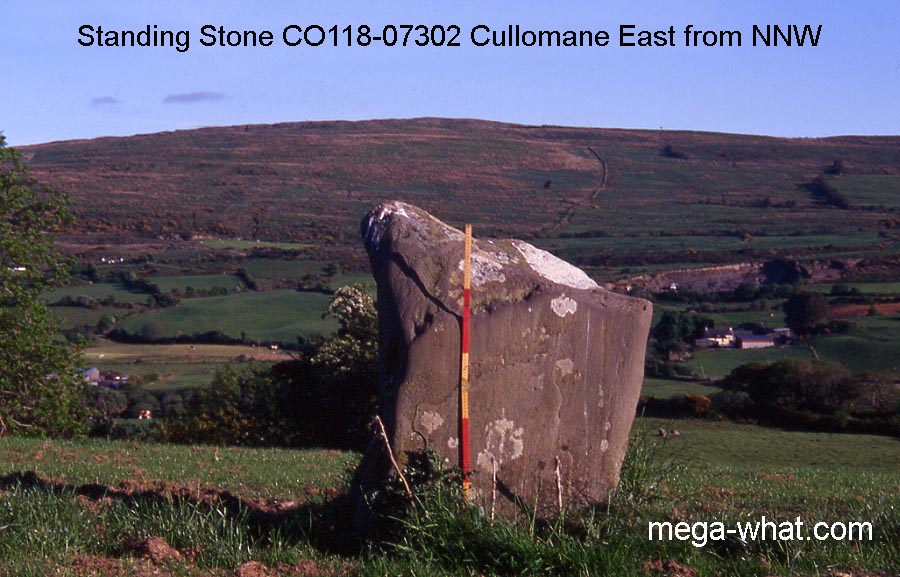 This Standing Stone at Cullomane (Colomane) East is between Bantry and Drimoleague, 2km or so west of Dromore.
It is only 50m or so away from Five Stone Circle CO118-07301 and possibly an outlier for it but perhaps a separate entity.
It has now fallen northwards so the few old pictures I have of it standing are included here.
This Standing Stone at Cullomane (Colomane) East is between Bantry and Drimoleague, 2km or so west of Dromore.
It is only 50m or so away from Five Stone Circle CO118-07301 and possibly an outlier for it but perhaps a separate entity.
It has now fallen northwards so the few old pictures I have of it standing are included here.
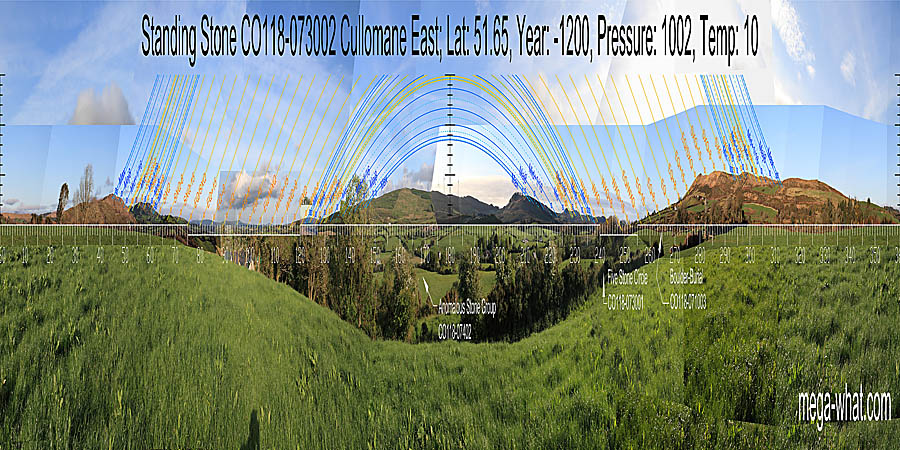 South is on the eastern slope of a dip [Pic]. North is in a dip [Pic].
To both sides the luni-solar sequence runs down through a dip and up again to the high ground where, at the major
standstillLunistice positions vary cyclically over an 18.6 year period but are fairly static for more than a year at either end of the range,
lunisticesLunistices are the most northerly and southerly moons of the month. The lunar equivalent of solstices - more.
rise from a hilltop and set into a dip.
South is on the eastern slope of a dip [Pic]. North is in a dip [Pic].
To both sides the luni-solar sequence runs down through a dip and up again to the high ground where, at the major
standstillLunistice positions vary cyclically over an 18.6 year period but are fairly static for more than a year at either end of the range,
lunisticesLunistices are the most northerly and southerly moons of the month. The lunar equivalent of solstices - more.
rise from a hilltop and set into a dip.
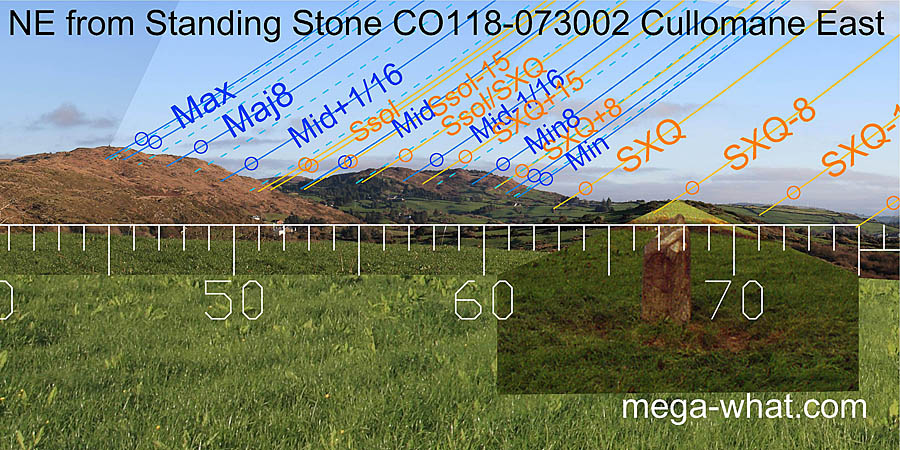 More of the further landscape is visible from here than from the circle but the short walk between the two monuments has not made any significant difference
to the values of those more distant points that are visible from both. In fact the line between them could be used as a baseline for observations, enabling greater precision.
A useful set of solar markers as well as the lunar midpoint are additionally visible from here.
More of the further landscape is visible from here than from the circle but the short walk between the two monuments has not made any significant difference
to the values of those more distant points that are visible from both. In fact the line between them could be used as a baseline for observations, enabling greater precision.
A useful set of solar markers as well as the lunar midpoint are additionally visible from here.
The Standing Stone was set so that its long axis points towards Inchybegga Hill and the quarter-month south of the summer cross-quarter.
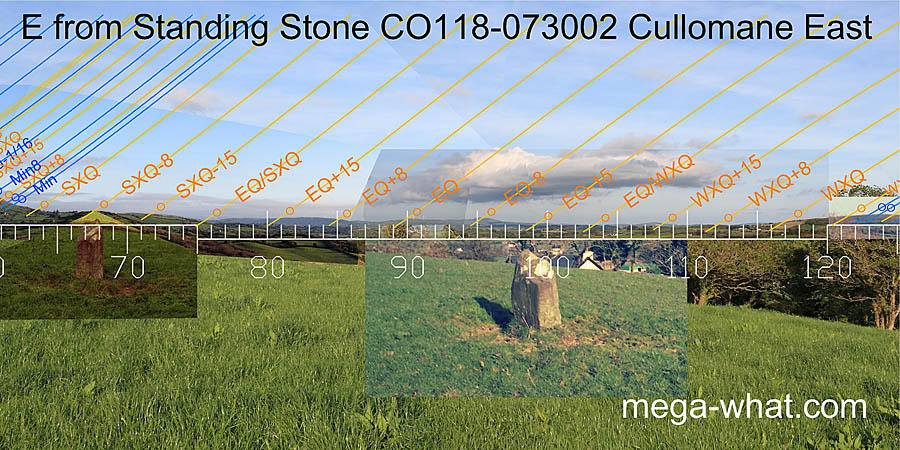 The eastern skyline is fairly useful with both the equinox and the quarter-month to its south on hilltops.
The midpoint between the equinox and the summer cross-quarters are in the centre of a wide dip as, though less obviously, is the one between the equinox and the winter cross-quarter.
The eastern skyline is fairly useful with both the equinox and the quarter-month to its south on hilltops.
The midpoint between the equinox and the summer cross-quarters are in the centre of a wide dip as, though less obviously, is the one between the equinox and the winter cross-quarter.
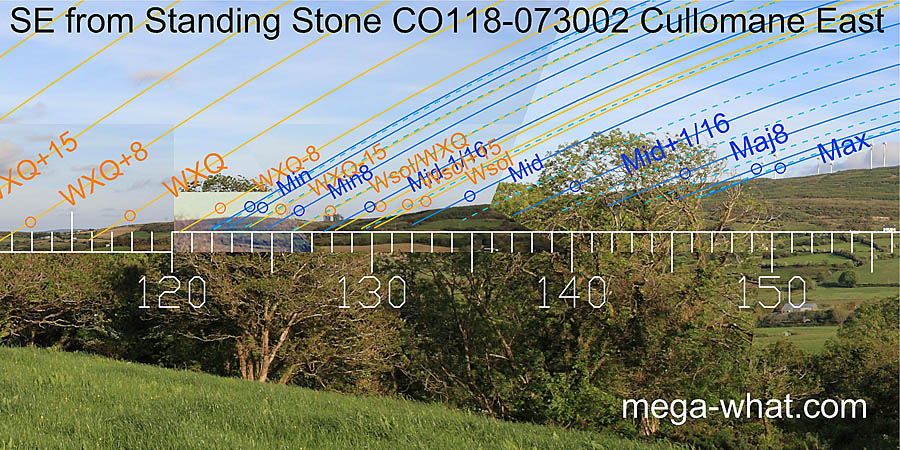 To the south-east, the bottom of the dip at the base of the long slope marks the solstice / cross-quarter midpoint.
Above the dip, the winter solstice occur at an obvious step/break. On the other side of the dip, the hill has the minor
standstillLunistice positions vary cyclically over an 18.6 year period but are fairly static for more than a year at either end of the range
on its top and the winter cross-quarter at its northern foot.
To the south-east, the bottom of the dip at the base of the long slope marks the solstice / cross-quarter midpoint.
Above the dip, the winter solstice occur at an obvious step/break. On the other side of the dip, the hill has the minor
standstillLunistice positions vary cyclically over an 18.6 year period but are fairly static for more than a year at either end of the range
on its top and the winter cross-quarter at its northern foot.
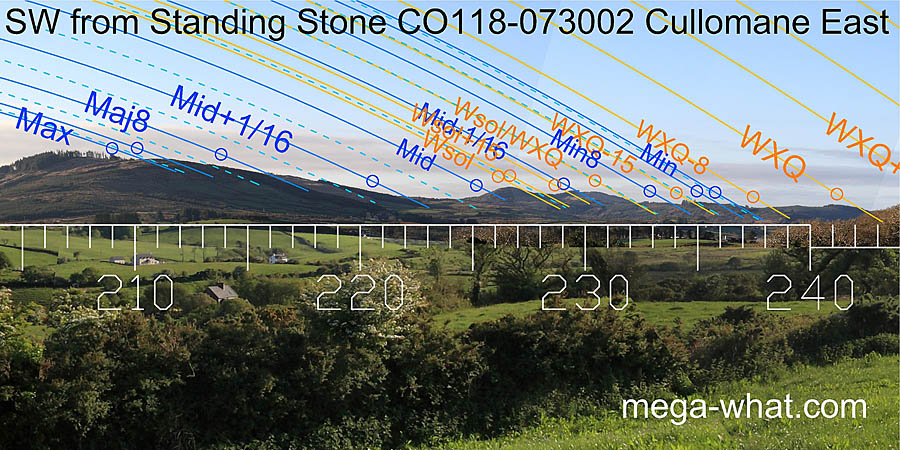 The fit of this very useful south-western horizon is very similar to that from the stone circle.
The lunar major standstillLunistice positions vary cyclically over an 18.6 year period but are fairly static for more than a year at either end of the range
is in a dip in the top of Derryvahalla Hill.
Two breaks/dips in the slope mark the eighth and a sixteenth the a hilltop marks the winter solstice.
The next hilltop is another lunar sixteenth while the western basal step is half-way between solstice and cross-quarter which itself occurs at the notch between
the end of the ridge and its terminal hill.
The fit of this very useful south-western horizon is very similar to that from the stone circle.
The lunar major standstillLunistice positions vary cyclically over an 18.6 year period but are fairly static for more than a year at either end of the range
is in a dip in the top of Derryvahalla Hill.
Two breaks/dips in the slope mark the eighth and a sixteenth the a hilltop marks the winter solstice.
The next hilltop is another lunar sixteenth while the western basal step is half-way between solstice and cross-quarter which itself occurs at the notch between
the end of the ridge and its terminal hill.
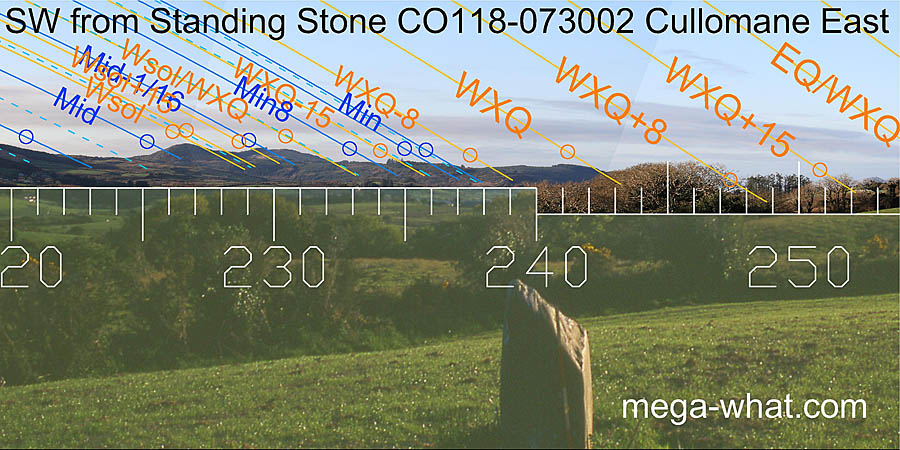 In this direction the axis of the Standing Stone was more towards the cross-quarter.
In this direction the axis of the Standing Stone was more towards the cross-quarter.
This picture also shows that part of the Muintirvara (Sheep's Head) peninsula should be visible and that the half-month to the north of the winter cross-quarters are marked by one of its hills.
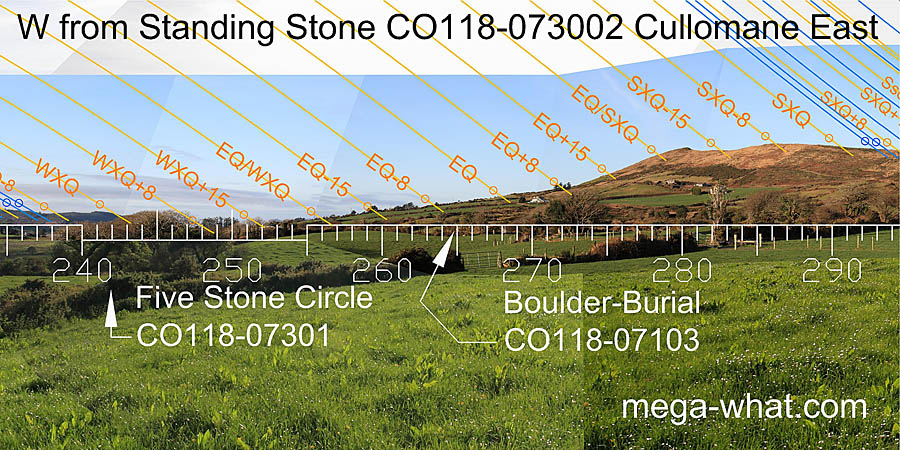 To the west, views down the valley are obscured. Above that the slope is relatively smooth alt="W though some undulations do occur and were made use of.
The first obviously good mark is the quarter-month to the south of the cross-quarter.
To the west, views down the valley are obscured. Above that the slope is relatively smooth alt="W though some undulations do occur and were made use of.
The first obviously good mark is the quarter-month to the south of the cross-quarter.
 The north-western sequence begins on a hilltop, with the quarter-month south of the cross-quarter, then the cross-quarter itself at a break in the slope.
The lunar minor eighth is at the south basal step of a hump that has a lunar sixteenth on its top and the summer solstice in its north basal dip.
There follows a nice undulating section which gives good markers for the remainder of the
lunisticeLunistices are the most northerly and southerly moons of the month. The lunar equivalent of solstices - more.
range.
The north-western sequence begins on a hilltop, with the quarter-month south of the cross-quarter, then the cross-quarter itself at a break in the slope.
The lunar minor eighth is at the south basal step of a hump that has a lunar sixteenth on its top and the summer solstice in its north basal dip.
There follows a nice undulating section which gives good markers for the remainder of the
lunisticeLunistices are the most northerly and southerly moons of the month. The lunar equivalent of solstices - more.
range.
This is one of a local group of monuments that utilise these same horizons in slightly different ways from positions about 200m apart.
The nearest (other than the adjacent Stone Circle) are:
- Boulder-Burial CO118-071003 to the west
- Anomalous Stone Group CO118-074002 to the south-east.
A further variant usage of Glanatnaw Hill to the north-east may be seen from Inchybegga which is 1.3km closer to it.
A Stone Axe was found, not far from here, in 2005, See Details
References
- Archaeological Survey of Ireland, record details. www.archaeology.ie/archaeological-survey-ireland
- POWER, D. et al. 1992 Archaeological Inventory of County Cork, Volume 1: West Cork. Dublin: Stationary Office. p50:no.289.
